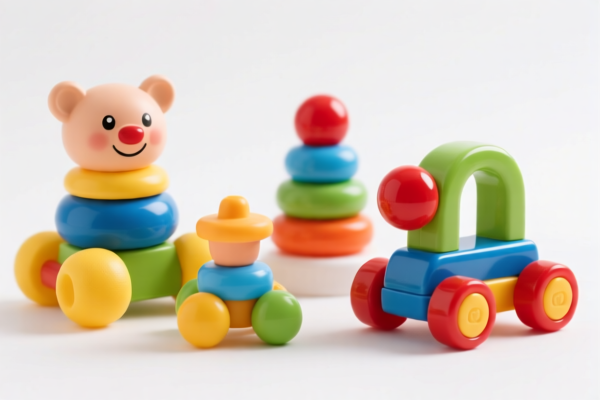| HS Code | Official Doc | Tariff Rate | Origin | Destination | Effective Date |
|---|---|---|---|---|---|
| 9503000090 | Doc | 30.0% | CN | US | 2025-05-12 |
| 9503000071 | Doc | 30.0% | CN | US | 2025-05-12 |
| 6815994170 | Doc | 55.0% | CN | US | 2025-05-12 |
| 6815992000 | Doc | 55.0% | CN | US | 2025-05-12 |
| 6810195000 | Doc | 58.9% | CN | US | 2025-05-12 |
| 6810990080 | Doc | 55.0% | CN | US | 2025-05-12 |




Play house toys, also known as pretend play toys or housekeeping toys, are designed to simulate a domestic environment and encourage imaginative role-playing, primarily centered around daily life activities within a home.
Material
These toys are commonly manufactured from:
- Plastic: Durable, affordable, and easily molded into various shapes, plastic is the most prevalent material. Different grades of plastic are used, with higher quality plastics being more resistant to wear and tear.
- Wood: Offers a classic aesthetic and is often favored for its durability and sustainable qualities. Wood toys often feature non-toxic paints and finishes.
- Fabric: Used for items like bedding, clothing for dolls, and soft furnishings, adding a tactile element to the play experience.
- Metal: Less common, but found in some miniature kitchen appliances or furniture for added realism and longevity.
Purpose
The primary purpose of play house toys is to facilitate:
- Imaginative Play: Encouraging children to create scenarios and stories, fostering creativity and narrative skills.
- Social-Emotional Development: Role-playing allows children to explore social dynamics, practice empathy, and develop communication skills.
- Cognitive Development: Simulating real-life tasks aids in problem-solving, understanding cause-and-effect, and developing organizational skills.
- Language Development: Children often engage in verbal communication while playing, expanding their vocabulary and practicing sentence structure.
Function
Play house toys function by providing representations of:
- Household Objects: Miniature furniture (beds, tables, chairs), kitchen appliances (stoves, refrigerators, sinks), bathroom fixtures, and cleaning supplies.
- Family Members: Dolls representing parents, siblings, and other family members.
- Food and Provisions: Play food, dishes, and utensils for simulating meal preparation and dining.
- Daily Life Activities: Toys enable children to mimic cooking, cleaning, eating, sleeping, and other everyday routines.
Usage Scenarios
- Indoor Play: Predominantly used within a home environment, often in dedicated playrooms or bedrooms.
- Solo or Group Play: Can be enjoyed independently or with siblings, friends, or caregivers.
- Structured or Unstructured Play: Children may engage in free-form play or participate in guided scenarios led by adults.
- Dollhouses: Frequently used in conjunction with dollhouses to create a complete miniature living space.
Common Types
- Dollhouses: Miniature houses with rooms and furniture, providing a setting for imaginative play.
- Kitchen Playsets: Include stoves, refrigerators, sinks, and play food, enabling children to simulate cooking and meal preparation.
- Furniture Sets: Miniature beds, tables, chairs, and sofas for furnishing a play house.
- Food Playsets: Plastic or wooden food items, allowing children to simulate grocery shopping and mealtime.
- Cleaning Sets: Miniature brooms, mops, and dustpans for simulating household chores.
- Tool Sets: Miniature tools for simulating home repairs.
- Baby Dolls and Accessories: Dolls representing infants and toddlers, along with accessories such as strollers, high chairs, and diapers.
- Cash Registers & Shopping Sets: Encourage role-playing scenarios involving shopping and financial transactions.
Play house toys generally encompass a variety of items designed for children's imaginative role-playing, often replicating household items or settings. These can include miniature furniture, kitchen sets, dolls, and related accessories.
The following HS codes are relevant based on the provided reference material:
-
9503000090: This HS code covers Tricycles, scooters, pedal cars and similar wheeled toys; dollsʼ carriages; dolls, other toys; reduced-scale (“scaleˮ) models and similar recreational models, working or not; puzzles of all kinds; parts and accessories thereof. This is a broad category and could include doll houses and related miniature toys.
- 95: Toys, games and sports equipment; gymnastic or sporting articles; parts and accessories thereof.
- 03: Tricycles, scooters, pedal cars and similar wheeled toys; dollsʼ carriages; dolls, other toys; reduced-scale (“scaleˮ) models and similar recreational models, working or not; puzzles of all kinds; parts and accessories thereof.
- 000090: Other (within the broader category).
-
9503000071: This HS code specifically covers “Childrenʼs productsˮ as defined in 15 U.S.C. § 2052: Other: Labeled or determined by importer as intended for use by persons: Under 3 years of age. If the play house toys are specifically designed for children under 3 years of age, this code may be applicable.
- 95: Toys, games and sports equipment; gymnastic or sporting articles; parts and accessories thereof.
- 03: Tricycles, scooters, pedal cars and similar wheeled toys; dollsʼ carriages; dolls, other toys; reduced-scale (“scaleˮ) models and similar recreational models, working or not; puzzles of all kinds; parts and accessories thereof.
- 000071: Other: Labeled or determined by importer as intended for use by persons: Under 3 years of age.
Regarding HS code 9503000071, please note that the toys must be labeled or determined by the importer as intended for use by persons under 3 years of age. This may require specific documentation or testing to confirm compliance with the relevant safety standards defined in 15 U.S.C. § 2052.
Customer Reviews
No reviews yet.